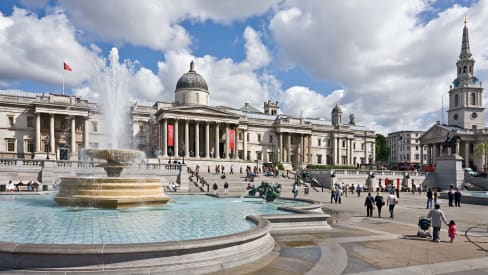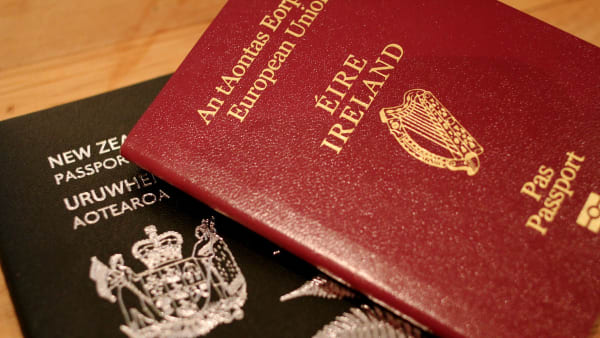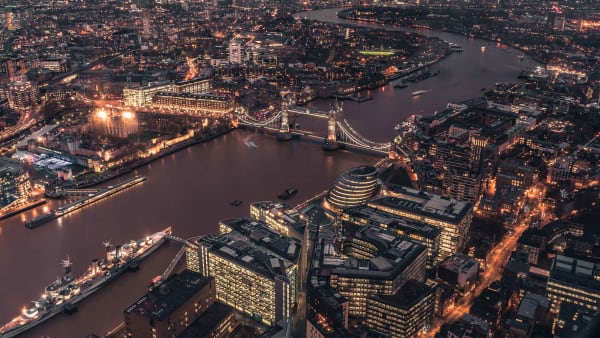Trafalgar Square
Trafalgar Square is one of the busiest and most well-known squares in London and an important site for social gatherings and political demonstrations.
Trafalgar Square
Trafalgar Square is one of the busiest and most well-known squares in London and an important site for social gatherings and political demonstrations.
Trafalgar Square is a public 19th-century square in Central London. The square, arguably the most well-known in London, is famous for being a social gathering point as well as for its notable sights and monuments. The most prominent of them are the National Gallery and Nelson’s Column.

Flanking the column are also two fountains and four lions, which have become sites of tourist and political focus over the years, much like the rest of the square. The Fourth Plinth, on the northwestern side of the square, is an empty plinth dedicated to hosting temporary art commissions. Other buildings facing the square are St Martin-in-the-Fields, Canada House, and South Africa House.
The site has been significant since the 13th century. At the time, it used to host the King’s Mews, which were later moved to Buckingham Palace. The land plot was then cleared and the construction works that would transform the area into what it is today began after 1826.
The name “Trafalgar Square” was chosen to commemorate the 1805 Battle of Trafalgar, in which the British, led by Admiral Nelson, defeated Napoleon’s French and Spanish fleet. In addition to the name, the square saw the addition of Nelson’s Column in 1843, just one year before its public opening in 1844. The bronze lions, meant to represent Nelson’s heroism, were only added in 1867.
Every year, for twelve days before and after Christmas, a tree donated by Norway is erected in the middle of the square.
Location
Trafalgar Square, London WC2N 5DS.
Trafalgar Square is located just north of the River Thames, between Covent Garden (to the east), St. James’s (to the west), and Soho (to the north).
Just overlooking the square is the National Gallery, and right behind it the National Portrait Gallery, another major London museum. Several other, like Leicester Square, Piccadilly Circus (northeast), and Charing Cross station (just west of it) are not far from the square.
Trafalgar Square transport and directions
If you are taking the Tube, the closest stop to Trafalgar Square is Charing Cross, along the Bakerloo and Northern lines stop. If you are taking the Piccadilly line, you can get off at Leicester Square (also on the Northern line) or Piccadilly Circus (also on the Bakerloo).
As for buses, lines 6, 9, 24, 29, 87, and 176 all have stops in Trafalgar Square. If none of these lines works for you, routes 11, 15, and 91 stop in the street just east of Trafalgar Square.
You can find a summary of the public transport options in the table below.
| Method |
|---|
| Lines |
| Stops |
| Method | Underground | Bus |
|---|---|---|
| Lines | Northern, Piccadilly, Bakerloo | 6, 9, 11, 15, 24, 29, 87, 91, 176 |
| Stops | Charing Cross, Leicester Square, Piccadilly Circus | - |
You can always take a cab, but we don’t recommend it, since the square is one of the most central in London and traffic can be slow in these areas. Taking a taxi would be costly and not very time-effective.
Nearby sights
National Gallery - overlooking Trafalgar Square.
National Portrait Gallery - 100 m (322 feet) north, 1-minute walk, behind the National Gallery.
St James’s Park - 350 m (0.2 miles) southwest, 5-minute walk.
Leicester Square - 390 m (0.2 miles) north, 3-minute walk.
Chinatown - 400 m (0.3 miles) north, 5-minute walk.
Piccadilly Circus - 500 m (0.3 miles) northwest, 7-minute walk.
Covent Garden - 550 m (0.3 miles) northeast, 7-minute walk.
London Transport Museum - 700 m (0.4 miles) east, 9-minute walk.














